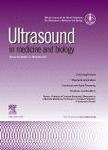版权所有:内蒙古大学图书馆 技术提供:维普资讯• 智图
内蒙古自治区呼和浩特市赛罕区大学西街235号 邮编: 010021

作者机构:Sunnybrook Research Institute and Department of Medical Biophysics University of Toronto Toronto ON Canada Joint Graduate Department of Biomedical Engineering University of North Carolina and North Carolina State University NC USA FujiFilm VisualSonics Inc Toronto ON Canada
出 版 物:《Ultrasound in Medicine & Biology》 (超声在医学和生物学中的 应用)
年 卷 期:2019年第45卷第Sup1期
页 面:S13-S13页
学科分类:10[医学]
摘 要:Acoustic angiography is a contrast imaging approach in which the superharmonics associated with low frequency excitation of microbubbles are received and processed over a broad bandwidth at a much higher frequency. As demonstrated by Dayton and colleagues, this technique facilitates the visualization of the microvasculature with a resolution typical of micro computed tomography and with superior contrast-to tissue-ratios than conventional nonlinear processing. To date dual frequency contrast imaging has been performed with a 2-4MHz annulus coaligned with 25-30MHz single element focused transducer operated by a Vevo770 (Visualsonics) scanner. This technology has limitations (mechanical scanning, single focus, limited focal depth) which hinder its clinical use but which could be alleviated using dual-frequency arrays (DFA). In this presentation we first describe the performance and applications of mechanical acoustic angiography and early results from the development of dual frequency array devices for acoustic angiography. The logical extension to array based designs is then explored. We built prototype dual frequency devices in both a vertical and horizonal topology. The horizonal topography consisted of a central 256 element high frequency array (HF, 20 MHz) flanked by two single element low frequency transducers(LF, 2 MHz) that extended for the length of the HF array. The vertical topography consisted of a 32-element LF transmitter array positioned behind a 256-element HF receiver array. Both arrays were built from piezoelectric composites. The HF backing material, between the two piezoelectric layers in the vertical design is weakly and highly attenuating at 2 MHz and 20 MHz, respectively. Two matching layers on the LF array and 4 matching layers on the HF array were used to improve transmission throughout the whole array structure. An elevation lens was added to focus the receive component at around 9 mm. Impedance and hydrophone measurements were performed to e